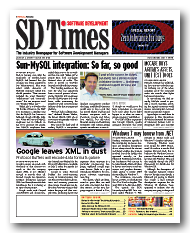Facebook FAIL and the helpless of using SaaS platforms
 Wow, did Facebook blow it with its latest redesign. The new, simpler navigation system, unveiled on Feb. 4, was intended to make it easier for people to stay updated, discover content and interact with applications. Instead, the new nav structure is a “bag of hurt,” to borrow the phrase that Apple’s Steve Jobs uses to describe Blu-ray media.
Wow, did Facebook blow it with its latest redesign. The new, simpler navigation system, unveiled on Feb. 4, was intended to make it easier for people to stay updated, discover content and interact with applications. Instead, the new nav structure is a “bag of hurt,” to borrow the phrase that Apple’s Steve Jobs uses to describe Blu-ray media.
Yes, as a heavy user of the system, I’m quite annoyed at Facebook. With the new nav system, it is apparently impossible to get a comprehensive and consistent listing of your friends’ status updates. The recommend method, to use Friends -> Status Updates, yields a list that mysteriously skips many friends, even from one moment to the next. And what’s with the new default view of “Top News,” a seemingly random collection of old updates that aren’t even in chronological order?
You blew it, Facebook. And not for the first time; the company regularly changes privacy settings and terms-of-use policies, settings off storms of customer protests.
Within their failure, however, demonstrates the weakness of SaaS. Any change to a Software-as-a-Service platform will make some users unhappy. It may also make some users happy, but that’s cold comfort for those who don’t like the changes but are helpless to do anything about it.
That’s true not only of social media sites like Facebook or Twitter, but also of business-style SaaS applications. Every time the oh-so-clever programmers add a nifty feature, redesign a menu, change a default or delete a function, they’re forcing all their customers to change as well. SaaS platform changes can disrupt productivity and really annoy end users and administrators, especially if takes away key functions or breaks third-party add-ins.
Contrast that with standard shrink-wrapped software. If you don’t like Microsoft Office 2007, you can stay on (or roll back to) Office 2004 forever. If you don’t like Apple’s Aperture 3, you can remain on Aperture 2. If you find that there are plug-in problems with the latest version of Firefox 3.6, you can downgrade to Firefox 3.5 or even 2.x. Heck, I’m running Photoshop 8.0 and QuarkXPress 6.52, and see no reason to upgrade.
Users of SaaS applications generally must upgrade whenever the platform owner dictates. Some SaaS vendors, of course, are more customer-centric than Facebook, and allow users to try out a beta of a new application version prior to roll-out and send feedback. Some also allow users to choose when they migrate; often there’s a deadline, but they give customers some control over their software environment. I’ve seen some SaaS vendors allow their customers to say on the “old” platform for a year or longer before forcing a migration.
There’s a cautionary tale in the latest Facebook fiasco. SaaS vendors, especially those with a very large user base, should be very careful when making platform changes that are imposed on unwilling customers. Whenever a company says, as Facebook does, that the changes make thing “easier,” beware. Easier for whom? In this case, not for many frustrated and confused Facebook users, going by the overwhelmingly negative feedback. Let’s learn from their mistakes, and not turn our SaaS customers into helpless victims.
>> Update 2/11/2010: Andrew Mager from ZDNet has posted a workaround that helps you fix your Facebook news feed to be chronological. It appears to help somewhat. Thanks, Andrew!


Love your distinction between shrink-wrapped and Saas applications. I still keep a copy of PhotoShop LE 5.0 handy because it lets me create layer masks — something that PhotoShop Elements can’t do. (Elements can create masks on adjustment layers, but not on image layers.) I then import the layer masks into Elements, which lets me edit the masks, even though it doesn’t let me create them. Long live shrink wrap!